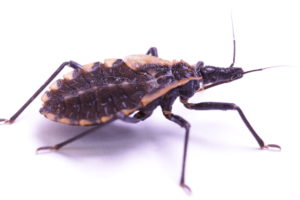Diagnosing Chagas disease in dogs
Texas A&M Veterinary Medical Diagnostic Lab reminds dog owners to be aware of kissing bug, offers advice about testing
February is typically a time of love and affection. However, this month the Texas A&M Veterinary Medical Diagnostic Laboratory, TVMDL, is reminding dog owners that some kisses can be harmful.
Chagas disease, spread by a family of insects known as “kissing bugs,” is a zoonotic disease caused by infection with the protozoan parasite Trypanosoma cruzi.
Carlos Rodriguez, TVMDL serology section head, said T. cruzi can infect humans and multiple species of domestic and wild animals. Veterinary medicine has primarily focused on infections in dogs due to their significance as companion and working animals and the similar ways infections manifest in humans.
How Chagas disease spreads in humans and dogs
Kissing bugs are blood-feeding insects within the Reduviidae family. After feeding on an infected animal, kissing bugs harbor the T. cruzi parasite in their digestive tracts. Definitive hosts, such as humans and dogs, are infected through exposure to the kissing bug’s feces.
Rodriguez said kissing bugs get their name from their tendency to bite people around the face or mouth. After biting, the kissing bug will deposit feces into the wound, thus transmitting T. cruzi. Although this is the most typical route of transmission in humans, he said dogs are thought to get Chagas disease primarily from ingesting a kissing bug infected with T. cruzi.
Once infected, dogs may remain asymptomatic for months or years before noticeable clinical signs appear, while some dogs never develop clinical signs. Of the dogs that do develop signs, there are acute and chronic phases of the disease.
Most clinical signs are similar to that of heart disease. Less severe signs include lethargy, depression and a lack of appetite, whereas more severe signs include difficulty breathing and sudden death.
The challenges of diagnosing Chagas disease
Diagnosis of Chagas disease in dogs can be challenging, Rodriguez said. Currently, testing options for living dogs are limited.
“There is no true ‘gold standard’ test,” Rodriguez said. “There really isn’t a definitive test that currently exists unless you can find evidence of the T. cruzi parasite itself, either circulating in the blood or via histopathologic findings in infected tissues.”
In living dogs, serologic testing is the primary method of diagnosing Chagas disease. Serologic testing uses a dog’s serum to detect antibodies against T. cruzi. A positive antibody titer indicates a dog has been exposed to, and likely infected with, the parasite. However, there are limitations with this method of testing.
Rodriguez said that cross-reactivity with Leishmania infantum, a closely related parasite, is known to occur when testing for T. cruzi. Because of this, Rodriguez recommends clients view results within the context of the situation and consider clinical signs, patient history and opportunity for exposure to the parasite, especially in areas where both organisms may be endemic.
Testing for Chagas disease at TVMDL
TVMDL tests for Chagas disease using a serologic assay called an indirect fluorescent antibody, IFA, test. Annually, TVMDL performs around 1,800 IFA tests for Chagas in dogs, of which about 20% come back positive for T. cruzi antibodies.
The IFA test is performed on a glass microscope slide separated into multiple sections, or wells. Each well contains killed T. cruzi organisms. After a dog’s serum is diluted, it’s added to its own well and the entire slide is incubated. This process allows any antibodies against T. cruzi present in the serum to bind to the parasites on the slide. After the initial incubation period, a secondary fluorescent antibody is added, and the slide is incubated again. This second round of incubation “tags” any of the dog’s antibodies left on the slide.
Following the second round of incubation, the slide is viewed under a fluorescent microscope. Wells that contain antibodies against T. cruzi will have organisms that glow bright green. After evaluation, the positive samples are further diluted and tested to determine the levels of T. cruzi antibodies present.
TVMDL recommends dog owners interested in testing for Chagas disease first consult their veterinarian to rule out other potential diagnoses.
For more information on testing for Chagas disease, or other tests, visit tvmdl.tamu.edu or call one of TVMDL’s full-service laboratories in College Station or Canyon.






